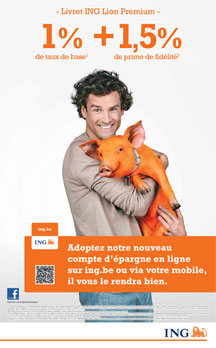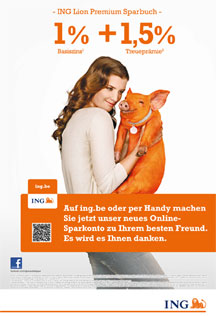ING in Belgium: from follower to leader in savings
ING in Belgium: from follower to leader in savings
If you are Belgian and earning EUR 2000 per month net, chances are you saving EUR 330 each month. That’s a lot compared to Europeans from other countries. Belgians save around 16.5% of their gross disposable income — one of the highest in the eurozone.
Numerous factors impact a country’s savings rate, from income taxes, inflation and level of interest rates to the nature of the pension system, housing prices or an expected rise in unemployment. An article by the Belgian Central Bank has also noted a positive correlation between individuals’ savings behaviour in Belgium and the level of public debt. Belgium’s debt is currently around 99% of GDP, above the 60% rule according to the Maastricht Treaty. As budget deficits build up, households reckon that taxes will have to be raised, or social benefits cut.
In Belgium, the main part of saving is currently oriented to a government scheme called ‘regulated savings’. Regulated savings accounts are savings products whereby the first EUR 1830 of interest per account are exempt from withholding tax.
Regulated savings deposits have increased sharply in recent years. The market has risen by nearly 50% in the last four years, from EUR 150 billion at the end of 2008 to nearly EUR 220 billion at the end of 2011. Much of this increase was caused by the uncertainty unleashed by the global financial crisis. But according to Tjeerd Wichers, head of savings products at ING Belgium, there are other factors at work. “Belgians are quite prudent. They save for their future, for their pension, and by paying off their mortgage.”
Sidebar
What are ‘regulated savings’?
In order to be sold as a regulated savings account, the product must meet certain conditions. First, the interest rate has to consist of two parts: a base rate, which cannot exceed the maximum of either 3% or the ECB refi rate; and a loyalty premium, which must be at least 25% of the base rate, but may not exceed 50% of the maximum base rate. The loyalty premium rewards customers who keep their money in the account for more than one year.
Stable funding base
Regulated savings are good for the local economy. “Savings are the ‘health check’ of every country,” says Wichers. Belgian banks enjoy a stable base of funding thanks to the high savings. The deposits are used to grant loans to local companies and households, thus fuelling the local economy.
Belgians’ enthusiasm for savings has also been good for ING in Belgium. Today, ING is an important player on the regulated savings market. But it has not always been that way.
In 2007, ING offered one product in the regulated savings market: the Green Savings Account. It could be purchased and managed in the branches, or in the Self’Banking areas inside the branches. At the end of 2007, ING had an 8.5% market share in regulated savings.

Becoming a challenger
Then the market shifted in 2008. Enticed by Belgium’s high savings rate, foreign competitors were eager to get a piece of the pie. “Some foreign banks, for funding reasons in their home country, are eager to raise money on the Belgian market,” says Lieselot Kempen, pricing and ALM analyst in the marketing department of ING’s retail operations in Belgium.
ING challenged the new competitors by launching the ING Lion Deposit, a pure internet savings account that offered the same high rate as the new foreign competitors. Moreover, ING had powerful weapons: strong brand awareness supported by a nationwide branch network. Belgium has around 85 banks, but the sector is dominated by four: BNP Paribas/Fortis, KBC, Belfius (formerly Dexia), and ING.
While the Green Savings Product, ING’s first regulated savings product, can only be managed in the branches, the new ING Lion Deposit can only be managed online. “This is an important point because we had to learn that if you mix the two [channels], you confuse the client. We had a multi-channel strategy, not a cross-channel strategy,” explains Wichers. In other words, each regulated savings product was designed to be distributed through its ‘own’ channel, instead of selling all products across all channels.

The tipping point
By the end of 2009, ING had become the fastest-growing savings bank in Belgium. When the market slowed down, ING responded in July 2010 by launching the Orange Savings Account, which is sold exclusively in the branches and offers a higher fidelity rate than the base rate. This feature was unique and marked a decisive turning point. “Most other banks followed us in creating this new type of savings account, which is typically designed for clients who do not need their money within the time span of a year,” says Kempen.
The launch of the Orange Savings Account was again a success. From December 2009 to September 2011, the overall regulated savings market for private depositors increased 13.6%; during the same period, ING’s regulator savings assets rose by almost 40%. “Our share of wallet is increasing as existing customers transfer money from other banks and new customers are coming in,” says Wichers.
Mobile banking
But market research indicated that pure online banking was growing fast. In April 2012, ING introduced the Lion Premium Account, a regulated online savings account, to respond to this trend. It is targeted at web-savvy customers who want to save for more than a year. “It’s been a flying start, not least because it’s our first savings account that can also be opened via a smartphone,” explains Wichers.
Furthermore, anyone can purchase the product online — even those who are not already clients of ING — making it unnecessary to go to a local branch. ING is the first of the four big banks to offer this extra convenience.

‘They love it’
Being faced with competition in your own backyard is never pleasant. But ING in Belgium turned a threat into an opportunity to speed up its already-planned transformation from being a purely branch-based bank to a multi-channel bank. Furthermore, ING in Belgium is not flooding the market with new savings products, but only introducing new products based on clear customer needs and reflecting the distribution channels customers want to use.
All of this is aimed to become truly customer-centric, and to support ING Bank’s strategy to become the preferred bank in all its markets by 2015. For example, the lower handling costs of ING’s online-only savings accounts are being returned to customers in the form of higher interest rates. And its newest savings product, the ING Lion Premium, pays out the annual loyalty premium earlier than all other banks. “Customers love it,” says Wichers.
